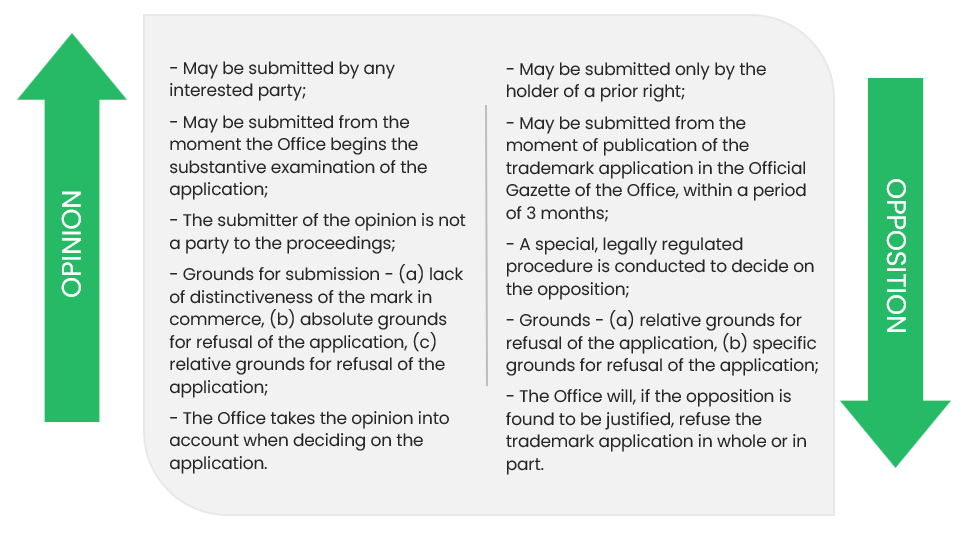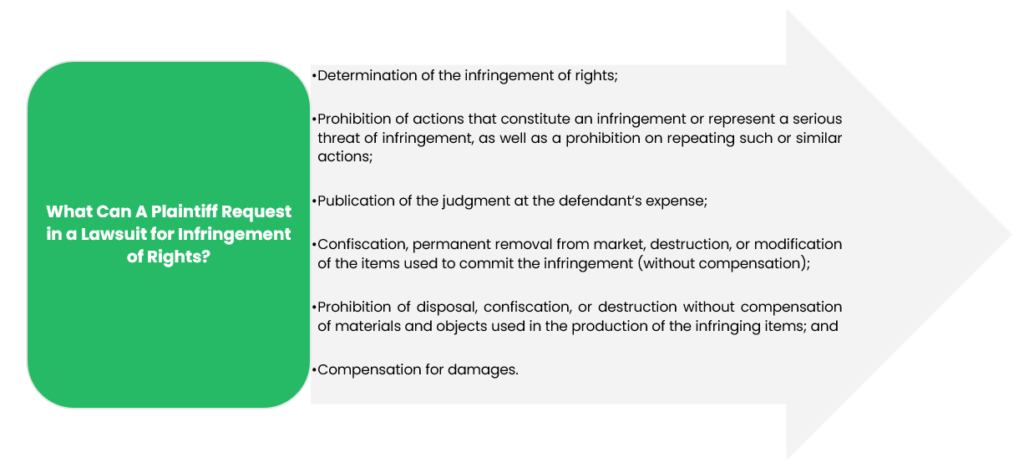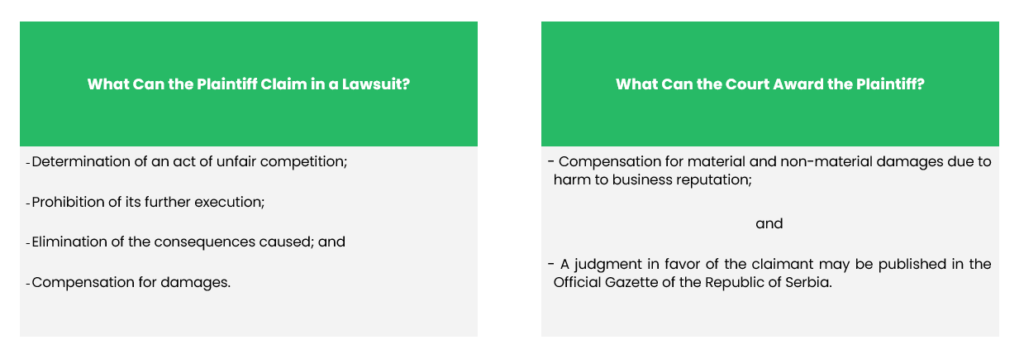Has your company discovered that someone is using a mark or trademark that is identical or very similar to it? Perhaps someone has already applied to register a mark that threatens your company’s trademark, or worse – products bearing the company’s trademark have already appeared on the market without its authorization? Such situations are not uncommon and can seriously undermine the company’s business, reputation, and financial security.
When the company’s intellectual property rights are infringed, a quick and effective response is crucial. Taking timely and appropriate measures can prevent further misuse, protect the value of the company’s brand, and minimize potential damage. Below, we reveal the specific measures the companies can take to ensure that their trademark – and their business – remain secure in their hands.
1. Does your company have a registered trademark? If not, act immediately!
Defining a brand is quite challenging, given that it ranges from a sign, through a trademark, to the overall reputation of a particular business entity (goodwill). The purpose of a trademark is to protect the entire investment in creating the brand. Therefore, although a trademark formally protects only the sign, it indirectly protects not only the sign but also the reputation and brand.
Companies that do not have a registered trademark risk insufficient legal protection of their business. Without a registered trademark, it will be harder to prevent potential abuses, and the available legal mechanisms will be more complicated and uncertain. Trademark registration is the first and most important step in ensuring market recognition and legal security for companies.
The process of trademark registration in Serbia takes place in several steps:
i. Filing an Application for Trademark Recognition and Initiating the Procedure
The first step is to submit an application to the Intellectual Property Office (hereinafter referred to as “Office“). If the application contains all the prescribed elements on the date of submission, it is assigned a submission date and entered into the Trademark Register.
In relation to this first step, one should understand why the application submission date is so important. Namely, from this moment the applicant acquires the right of priority in protecting the sign of the company against all other individuals who have later filed an application for the same or similar mark used to denote the same or similar goods or services. Additionally, if trademark registration procedure is successful, such trademark shall be deemed registered from the day of filing the application by the company instead of the day when the positive decision has been issued by the Office.
ii. Examination of the Application’s Regularity
The Office examines whether the application is “regular,” i.e., whether it contains all the elements prescribed by law. If this is not the case, the Office will invite the company in writing to rectify the application within a specified deadline.
iii. Substantive Examination of the Application
The Office examines whether the conditions prescribed by law for the recognition of the trademark are met. During this examination process, any interested party may submit a written opinion stating which condition/s for trademark recognition has/have not been met.
iv. Publication of the Trademark Application in the Official Gazette
If the application is regular and the Office believes there are no reasons to refuse the application for trademark recognition, the details from the application are published in the Official Gazette of the Office. The holder of prior right may file an objection to the registration of the company’s trademark within 3 months from the date of publication of the application, as explained below in detail.
v. Payment of the Prescribed Fee for Trademark Acquisition and Entry in the Trademark Register
If the company’s application meets the conditions for trademark recognition and no objection has been filed, or if an objection has been finally rejected or dismissed, the company will be invited to pay the fee for the first 10 years of protection and for the costs of publishing the trademark. Upon submission of proof of relevant payment, the Office will enter the recognized right into the Trademark Register and issue a trademark certificate.

2. A Competitor is Attempting to Protect a Mark That Would Infringe Your Company’s Trademark? Contest the Registration in Time!
When the company discovers that its competitor has filed an application to protect a mark, the registration of which would infringe upon the company’s trademark, it is crucial to react immediately to protect the company’s brand and business. Waiting for the Office’s response to such an application or for the completion of the registration can lead to complications and make it more difficult to protect rights. Trademark Law (hereinafter referred to as: “Law“) provides two key options for timely response: submitting an opinion on the trademark application and objection to the trademark registration.
a) Opinion on the Trademark Application – Preventative Intervention
During the substantive examination of the application for trademark registration, any interested party has the right to submit a written opinion to the Office explaining the reasons why they believe the applied mark does not meet the conditions for legal protection. The justified reasons include:
(a) the fact that the mark is not adequate for distinguishing the goods/services on the market, i.e., it is not allowing for a clear and precise determination of the subject of protection,
(b) absolute grounds for refusal of protection, or
(c) relative grounds for refusal of protection.
This is not a “formal” legal protection measure, and the person submitting the opinion is not a party to the proceeding, but it can have a significant impact on the registration process, as the Office may take the arguments into account when making a decision. Essentially, this is a way to indicate, without complex legal procedures, that the company believes the applied mark should not be registered, thus providing additional information that may be significant in deciding on the trademark registration.
b) Opposition to Trademark Registration – Decisive Legal Protection
The opposition mechanism in trademark registration proceeding, introduced into Serbian legislation through amendments to the Law several years ago, enables the holder of a prior right to proactively participate in the protection of its rights. Its introduction has altered the registration process concept, increasing its transparency and allowing prior rights holders to prevent the registration of a trademark that would infringe upon their rights.
The deadline for filing an opposition is strictly limited – the holder of a prior right has three months from the date of publication of the application in the Official Gazette of the Office to file an opposition against the registration of a trademark that may endanger its rights. An opposition may be filed on the basis of relative or specific grounds for refusal of the trademark application. The opponent must submit an opposition with the prescribed content, in accordance with the Regulation on the Content of the Trademark Register, the Content of Requests, Oppositions, and Proposals Submitted in the Procedure for Trademark Recognition and Protection, and the Data Published in the Official Gazette of the Competent Authority, along with all required supporting documents.
Once an opposition is filed, the Office examines its formal correctness, i.e., whether it comprises the prescribed content, whether it has been submitted within the prescribed deadline, and if the opposition was made by an authorized party. If any of these conditions are not met, the Office will issue a decision dismissing the opposition.
If the applicant fails to respond to the opposition within the prescribed deadline, its trademark application will be rejected to the extent specified in the opposition request.
After confirming that the objection fulfils the formal conditions, the Office will assess the merits of the opposition and issue one of the following decisions:
- Rejection of the opposition
If the Office determines that the opposition is unfounded, it will issue a decision rejecting the opposition, and the trademark registration procedure will continue.
- Acceptance of the opposition
If the Office determines that the opposition is founded, it will issue a decision refusing the trademark application, either entirely or partially. If the application is only partially rejected, the registration procedure will continue solely for the goods and services for which protection was not rejected (i.e., only if part of the application is rejected).
Both the opinion and the opposition serve as legal mechanisms that can help the company prevent the registration of a trademark that threatens its rights. However, there are key differences between them, which determine which mechanism is better suited for each specific situation:

3. Surprise in the Trademark Register – How to Combat Unfounded Registration?
When a trademark threatening business of some company which should not be registered appears on the market – whether due to infringement of the company’s prior rights, the applicant/holder’s conduct in bad faith, or non-compliance with legal conditions for protection – a timely and adequate response is required. Unlike the previous section referring to the situation when the trademark application is still not approved, below we are analyzing the scenario in which the disputed trademark is already registered. The legal framework of the Law provides a series of mechanisms that allow for the protection of the company’s rights. Below, acquaint yourself with the key institutions that the Law makes available:
a) Application for Declaration of Trademark Invalidity
A trademark can be declared invalid, in whole or for certain goods/services, if it is determined that certain legal conditions for trademark recognition were not met at the time of its registration. This procedure can be initiated at any time during the protection period of the trademark, meaning there is no time limit for challenging its legal validity.
The procedure is initiated with a written application for declaration of the trademark invalid, which must contain prescribed content and be supported by relevant attachments.
The application can be submitted by:
- The holder of a prior right or a person authorized by it
When invalidity is requested due to relative or specific grounds for refusal of protection;
- An interested party or the public prosecutor
When invalidity is requested due to absolute grounds for refusal of protection or due to the sign’s inability to enable distinction in commerce, i.e., clear and precise determination of the subject of protection.
After the procedure is conducted, the Office may issue:
- A decision rejecting the application, if it assesses that the conditions for invalidity are unfounded, or
- A decision declaring the trademark invalid in whole or for some goods/services, in which case the trademark is considered to have never existed, i.e. to not have produced effects from the very beginning.
b) Trademark Infringement Lawsuit – When and How to React?
Unauthorized use of the company’s protected mark is not just a business challenge – it is legal infringement that can seriously jeopardize the company’s brand and market position. If any party uses the company’s protected mark on the market without authorization, as defined by the Law, the company has the right to file a lawsuit for infringement of rights.
The deadline to initiate litigation is limited – a lawsuit can be filed within three years from the day the company became aware of the infringement and the infringer, and no later than five years from the day the infringement occurred or the last continuous infringement if it is ongoing. The plaintiff in this process can be the trademark holder, the applicant, or the acquirer of a trademark license, as well as the user of a collective trademark or a guarantee trademark.

Additionally, it is very important to consider the possibility of imposing an interim measure, which allows for the quick prevention of further infringements even before the conclusion of the court proceeding, including against those whose services were used in the infringement (intermediary). The court may issue various interim measures (for example, confiscation of goods, prohibition of using the disputed sign, etc.) at the request of the party that makes it likely that its right has been infringed or will be infringed. These measures can be issued even without prior statement from the opposing party if there is a risk of irreparable harm.
In legal transactions, ignorance of relevant laws is no excuse – if the trademark of the company is registered, its existence is publicly available information. Anyone operating in the market is obligated to be familiar with existing intellectual property rights. Therefore, a lawsuit for trademark infringement is one of the most effective legal remedies for protecting a company’s business identity, preventing unfair competition, and preserving market reputation.
c) Trademark Contestation Lawsuit – Stop Bad Faith
If the company encounters a situation where its competitor has registered a trademark that is significantly similar to the company’s trademark, and it was aware of the company’s previously used mark as well as the company’s market position and reputation, the legality of such action comes into question. The Law does not allow the registration of a trademark in cases of bad faith, and the company has the option to initiate a trademark contestation lawsuit.
A party whose legal interest is harmed may file a lawsuit requesting the court to declare them the applicant or the holder of the right in the following cases:
- If the trademark application was submitted contrary to the principles of good faith and honesty;
- If the mark was registered based on an application that was submitted contrary to the principles of good faith and honesty;
- If the mark was registered based on an application that violated legal or contractual obligations.
EXAMPLE: Imagine that you are very successful in the business of natural cosmetics and use the trademark “Bella Natural Cosmetics” in your business, and your former employee, who was familiar with your trademark, its reputation, and its usage in commerce, applies for “Bella Organics” as their own trademark with the intent to start their own natural cosmetics business. Since it had the aforementioned knowledge and still filed the application, you can file a lawsuit to contest the trademark. If the court determines that the application was filed contrary to the principles of good faith and honesty, it will issue a decision declaring you the applicant of such a trademark application.
d) Lawsuit for Recognition of Trademark Right – When a Competitor Appropriates Third-Party Mark
What if the company has invested years in building the recognition of its brand, but someone else has registered the company’s mark as their own before the company had the chance to do so? If the company has used the mark to designate goods/services before the filing of the disputed application or the registration of the disputed mark by another party for the same/similar goods/services, it may file a lawsuit requesting the court to declare the company the applicant or the holder of the trademark – provided that the company can prove that the mark was well-known in the sense of Article 6bis of the Paris Convention for the Protection of Industrial Property, for designating the company’s goods/services before the other party filed the application or registered the trademark.
This lawsuit enables the company to reclaim the right to the mark that it was the first to use in commerce. The key piece of evidence is the distinctiveness and recognition of the company’s mark. However, if the defendant proves that it has used the mark in commerce for the same or similar goods/services for an equal or even longer period than the company, the court will dismiss the company’s claim. The deadline for filing this lawsuit is five years from the date the disputed trademark was entered into the Trademark Register. Failure to file within this period results in the loss of the legal ability to contest the registration and protect the rights of the company.
4. From Customs to Inspection: Customs and Administrative Protection of Rights
In addition to the procedures before the Office, the regulations offer some other measures the company may undertake in case it becomes aware of the potential or actual breach of the company’s intellectual property right.
a) Protection of Rights Through Inspection Supervision
Imagine that goods bearing the company’s trademark appear on the market without authorization. Litigation is one option, but what if the company needs an immediate response? This is where state authorities step in, with powerful measures that can swiftly prevent further infringement of the company’s rights.
The Ministry of Internal and External Trade, through market inspection in the procedure of inspection supervision, monitors the production and trade of goods that infringe trademarks, while the tourism inspection intervenes in cases where trademark rights are violated in the tourism and hospitality sector. If the infringement involves pharmaceuticals, jurisdiction shifts to the Ministry of Health. The key advantage is that competent authorities do not have to wait for the company’s complaint – they can act ex officio.
What specific measures can the competent authorities take to protect the company’s trademark rights?

The most severe sanction is undoubtedly the final confiscation and destruction or removal of goods from circulation, which may result from a decision in proceedings before the competent court or an ex officio action by the competent authority if:
- there is reasonable suspicion that the goods infringe the company’s trademark rights;
- a breached party fails to initiate legal proceedings to protect its rights within the prescribed period after the competent authority, upon approving its request, temporarily seizes the goods and invites it to initiate such court proceedings; and
- the party from whom the goods were temporarily seized does not contest the reasons for the seizure.
EXAMPLE: Imagine that you own a luxury cosmetics brand and discover that a product bearing your trademark has appeared on the market – yet you did not produce such product, or ever authorized it. You submit a request to the market inspection, which conducts an on-site inspection and confirms that the disputed products bear your registered trademark without authorization. The competent authority immediately orders the temporary seizure of the goods and invites you to initiate court proceedings. If such a proceeding is initiated and concluded in the plaintiff’s favor, the competent authority may issue a decision on final confiscation and permanent removal of such products from the market.
b) Protection of Rights at the State Border
The Customs Law explicitly stipulates that goods infringing a registered trademark or any other intellectual property right cannot be freely imported or exported from the Republic of Serbia.
In practice, this means that customs authorities, acting in accordance with domestic regulations and international agreements, may suspend the release of goods or detain them:
- Ex Officio
if there is suspicion that the goods being imported or exported infringe an intellectual property right (e.g., unauthorized use of software, trademark infringement, etc.);
- Upon the company’s request
if the company submits a detailed request to the Customs Administration, using the prescribed form and providing all required supporting documents. The competent customs authority must inform the company of whether its request is approved or denied within 30 days of the date of submission. If the request is approved and the customs authority identifies goods that fall within the scope of the request, they will suspend the release or detain the goods accordingly.
If the aforementioned request of the company is approved, there is a possibility that goods suspected of infringing the company’s trademark may be destroyed under customs supervision, provided that the prescribed conditions are met. The destruction of goods entails physical destruction, recycling, or removal from commercial circulation. Consequently, such goods will not be released into free circulation, exported outside the customs territory of Serbia, re-imported, or placed under a special customs procedure.
It is important to emphasize that customs authorities can take action only if there is a duly registered trademark in the Republic of Serbia. Therefore, timely trademark registration is an essential step in ensuring stable and secure business operations. By doing so, the company not only makes it clear that it takes the protection of its brand, reputation, and investments seriously, but it also directly reduces the risk of counterfeits and prevents their entry into the market.
5. Unfair Competition: Lawsuit for Unfair Market Practices
In the modern business environment, brand recognition represents a key asset and the result of years of investment and strategic market positioning. However, it is not uncommon for competitors to attempt to exploit the reputation of already established businesses, resorting to practices that mislead consumers and disrupt fair market competition. Such situations require careful consideration of legal protection mechanisms, particularly the lawsuit for the unfair market practices.

EXAMPLE: Imagine that you have spent years building a recognizable brand and own the trademark “Master’s Bakery” – your bakery is synonymous with quality and has a loyal customer base. Then, a new bakery, “Bakery at the Master’s”, opens nearby, using an almost identical logo, packaging, and product presentation. Customers start assuming it is your new location, while the new “competitor” is actually exploiting your reputation to capture part of the market. In this scenario, you have the right to file a lawsuit for unfair competition and protect your brand from misuse.
It is crucial to understand that unfair competition is not compatible with the “regular” loyal market competition. The right to compete does not include the right to exploit another party’s market recognition or use their trademark. Among other things, unfair competition particularly includes practices where, in the course of business activities (including services), goods are sold bearing another party’s sign, trademark, or other designation – including the physical appearance and shape of the product – in a way that creates a justified likelihood of consumer confusion regarding the source, quality, and other characteristics of the goods or services.
Unfair competition is prohibited, but protection against unfair competition is provided through court proceedings based on a lawsuit filed by the injured party. The Law on Trade provides protection in such cases, with the key legal mechanism being a lawsuit for unfair market competition, which must be filed within six months from the date of becoming aware of the damage and the party responsible, and no later than three years from the conclusion of the infringing act.
6. Deceptive Advertising – Another Legal Basis for Lawsuit
Advertising is not just a tool to attract customers; it is also a powerful instrument that shapes market perception. When a competitor uses false or misleading claims to exploit another company’s reputation and mislead consumers into making the wrong choice, it is not only unethical – it is illegal. The Law on Advertising explicitly defines deceptive advertising as any advertisement, in any form, that misleads or is likely to mislead consumers and affects their economic behavior, thereby causing or potentially causing harm to a competitor. When determining whether an advertisement is deceptive, special consideration is given to its content concerning the intellectual property rights of the advertiser.
If a competitor advertises products using another company’s trademark, misleading consumers into believing they are purchasing that company’s product, or otherwise deceives them, such conduct constitutes deceptive advertising. In such a case, that company has the right to file a lawsuit before the competent court, requesting the cessation of such advertising, correction of false claims, and prohibition on future advertising that could mislead consumers. There is no need to wait for actual harm to occur – if there is a real risk of deceptive advertising, the company may preemptively request its prohibition. A timely response protects not only the company’s business but also consumer trust.
If the court upholds claim, it will order the defendant to cease such deceptive advertising, prohibit further misleading advertisements, and require the defendant, at their own expense, to publish the court’s decision or issue a correction of the misleading advertisement.
7. Regulations Provide Options – It’s Up to Companies to Use Them
Legal protection mechanisms exist to enable the companies to take the right steps at the right time, but their effectiveness depends on the company’s response. When the trademark of the company is at risk, the company cannot rely on the market to correct the injustice on its own – the company is the one who must act. Is the solution an objection, a lawsuit, an inspection, or something else? Every situation requires careful analysis and a precise strategy. Professional legal assistance in these matters can be crucial – the better the company understands the available legal actions, the greater are its chances of protecting its brand before the damage becomes irreversible.
Brands survive not only due to their quality but also because their owners are willing to protect them when it matters most. Awareness, timely action, and the right legal steps are the key to preserving the company’s identity in the market.
























